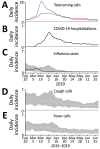Nowcasting (Short-Term Forecasting) of COVID-19 Hospitalizations Using Syndromic Healthcare Data, Sweden, 2020
- PMID: 35201737
- PMCID: PMC8888224
- DOI: 10.3201/eid2803.210267
Nowcasting (Short-Term Forecasting) of COVID-19 Hospitalizations Using Syndromic Healthcare Data, Sweden, 2020
Abstract
We report on local nowcasting (short-term forecasting) of coronavirus disease (COVID-19) hospitalizations based on syndromic (symptom) data recorded in regular healthcare routines in Östergötland County (population ≈465,000), Sweden, early in the pandemic, when broad laboratory testing was unavailable. Daily nowcasts were supplied to the local healthcare management based on analyses of the time lag between telenursing calls with the chief complaints (cough by adult or fever by adult) and COVID-19 hospitalization. The complaint cough by adult showed satisfactory performance (Pearson correlation coefficient r>0.80; mean absolute percentage error <20%) in nowcasting the incidence of daily COVID-19 hospitalizations 14 days in advance until the incidence decreased to <1.5/100,000 population, whereas the corresponding performance for fever by adult was unsatisfactory. Our results support local nowcasting of hospitalizations on the basis of symptom data recorded in routine healthcare during the initial stage of a pandemic.
Keywords: 2020. Emerg Infect Dis. 2022 Mar [date cited]. https://doi.org/10.3201/eid2803.210267; COVID-19; Dahlström Ö; Eriksson O; Jöud A; Källström R; SARS-CoV-2; Soltesz K; Suggested citation for this article: Spreco A; Sweden; coronavirus disease; epidemiology; et al. Nowcasting (short-term forecasting) of COVID-19 hospitalizations using syndromic healthcare data; forecasting; infectious diseases; medical informatics; nowcasting; public health; respiratory infections; severe acute respiratory syndrome coronavirus 2; viruses; zoonoses.
Figures


References
Publication types
MeSH terms
LinkOut - more resources
Full Text Sources
Medical
Miscellaneous

